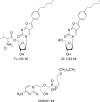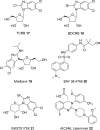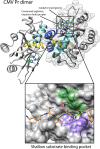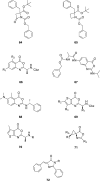Current and potential treatments for ubiquitous but neglected herpesvirus infections
- PMID: 25275644
- PMCID: PMC4254030
- DOI: 10.1021/cr500255e
Current and potential treatments for ubiquitous but neglected herpesvirus infections
Figures






















References
-
- Wald A.; Corey L.. Persistence in the population: Epidemiology, transmission. In Human Herpesviruses: Biology, Therapy, and Immunoprophylaxis; Arvin A., Campadelli-Fiume G., Mocarski E.. et al., Eds.; Cambridge University Press, Cambridge, U.K., 2007. - PubMed
-
- Chentoufi A. A.; Kritzer E.; Yu D. M.; Nesburn A. B.; Benmohamed L. Clin. Dev. Immunol. 2012, 2012, 187585. - PMC - PubMed
- Coleman J. L.; Shukla D. Hum. Vaccines Immunother. 2013, 9, 729. - PMC - PubMed
- Fu T. M.; An Z.; Wang D. Vaccine 2014, 32, 2525. - PubMed
- Boppana S. B.; Britt W. J.. Recent approaches and strategies in the generation of antihuman cytomegalovirus vaccines. In Human Cytomegaloviruses Methods and Protocols; Yurochko A. D., Miller W. E., Eds.; Humana Press: New York, 2014. - PubMed
-
- Human Herpesviruses: Biology, Therapy, and Immunoprophylaxis; Arvin A., Campadelli-Fiume G., Mocarski E. Jr., Moore P. S., Roizman B., Whitley R., Yamanishi K., Eds.; Cambridge University Press: Cambridge, U.K., 2007. - PubMed
-
- Davison A. J.Overview of classification. In Human Herpesviruses: Biology, Therapy, and Immunoprophylaxis, 2011/02/25 ed.; Arvin A., Campadelli-Fiume G., Mocarski E. Jr., Moore P. S., Roizman B., Whitley R., Yamanishi K., Eds.; Cambridge University Press: Cambridge, U.K., 2007. - PubMed
- Davison A. J.; Eberle R.; Ehlers B.; Hayward G. S.; McGeoch D. J.; Minson A. C.; Pellett P. E.; Roizman B.; Studdert M. J.; Thiry E. Arch. Virol. 2009, 154, 171. - PMC - PubMed
- McGeoch D. J.; Dolan A.; Ralph A. C. J. Virol. 2000, 74, 10401. - PMC - PubMed
Publication types
MeSH terms
Substances
Grants and funding
LinkOut - more resources
Full Text Sources
Other Literature Sources

